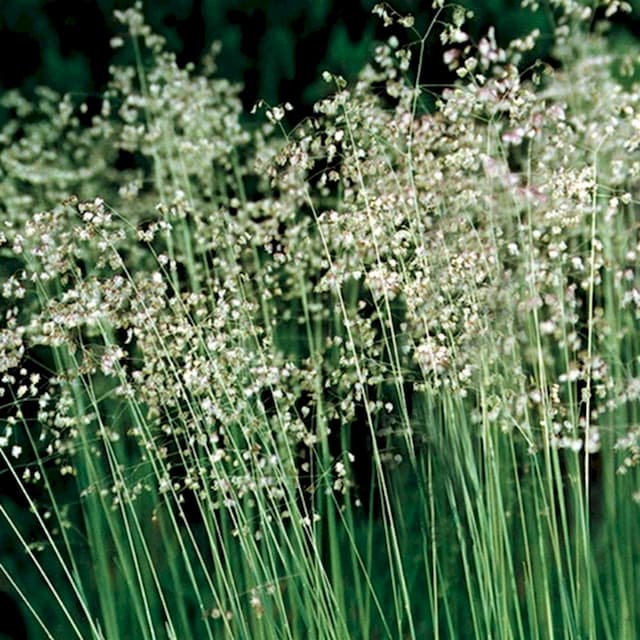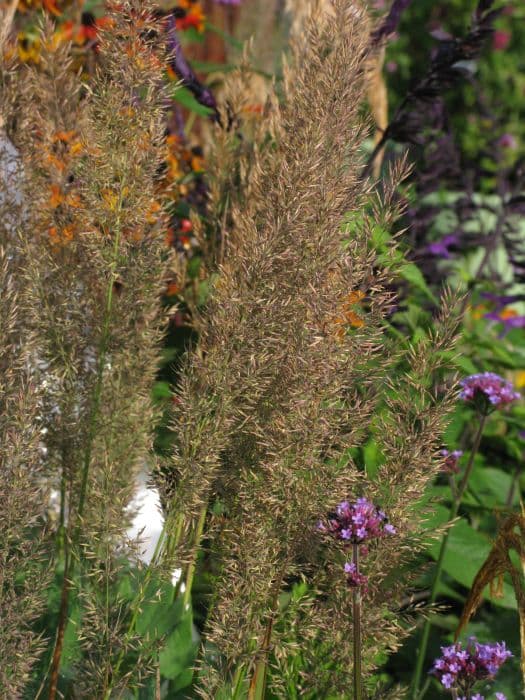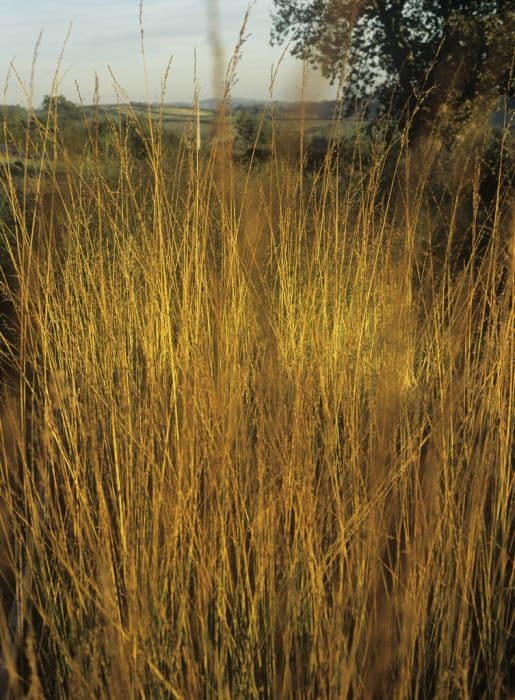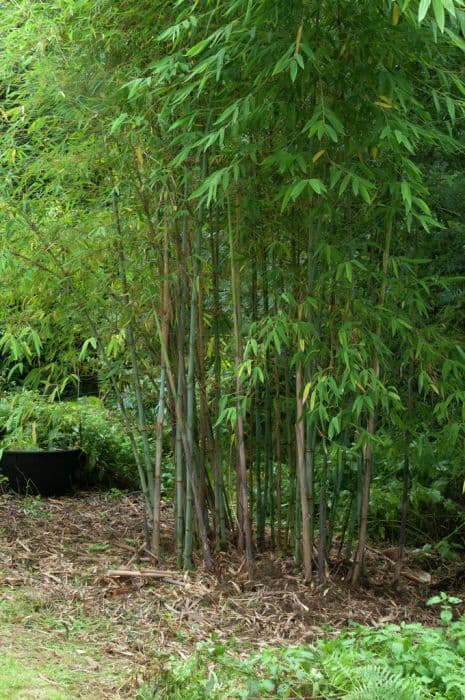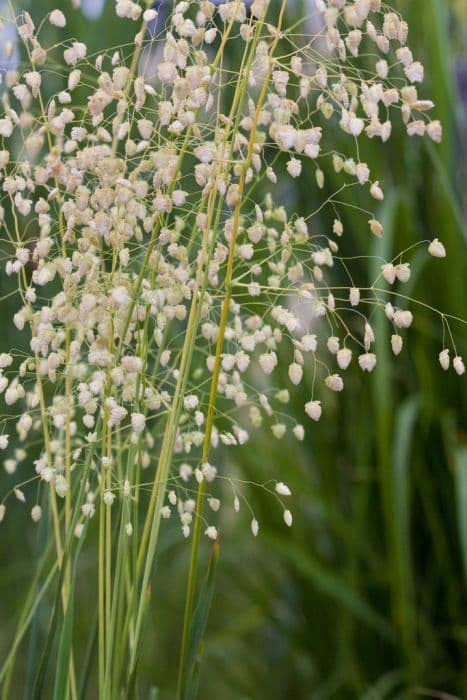Variegated Dwarf Bamboo Sasa kurilensis 'Shima-shimofuri' (v)

ABOUT
The plant known as the variegated Sasa bamboo features beautifully patterned foliage. Each broad leaf is marked with an irregular combination of green and pale yellow stripes that can vary from leaf to leaf, creating a dynamic and eye-catching dappled effect. The variegation adds a striking contrast to the plant, making it stand out against the more uniform greens commonly found in garden foliage. The leaves themselves are sturdy and have a slightly rough texture, appearing lush and full on the plant. The variegated Sasa bamboo exhibits strong growth, forming dense clumps thanks to its spreading habit. The stems, or canes, are relatively short and stout compared to those of taller bamboos, supporting the thick foliage. These canes are typically green but may sometimes have a hint of yellow that echoes the variegation in the leaves. As the seasons change, the leaves of the variegated Sasa bamboo might take on different hues or intensities of color, though the underlying pattern of green and pale yellow generally persists. This pattern of variegation makes it a highly decorative and sought-after plant for adding interest to gardens or as an ornamental feature in planters and landscapes. Its textured leaves and the way they catch the light provide a unique visual appeal, with the variegated leaves creating a cool, calming effect in the garden space.
About this plant
 Names
NamesFamily
Poaceae
Synonyms
Variegated Bamboo, Dwarf Bamboo, Gnome Variegated Bamboo
Common names
Sasa kurilensis 'Shima-shimofuri'.
 Toxicity
ToxicityTo humans
Sasa kurilensis 'Shima-shimofuri', commonly known as Kuril bamboo, does not have well-documented toxicity to humans. As with many plants, it is not recommended for ingestion due to the possibility of digestive discomfort or allergic reactions. If consumed, symptoms could include nausea, vomiting, or diarrhea. In the absence of specific toxicity information, treating the plant as potentially irritating if ingested is prudent. Always keep plants away from children who might inadvertently consume them.
To pets
Kuril bamboo is not specifically listed as toxic to pets. However, ingestion of plant material by animals can lead to gastrointestinal upset, including symptoms like vomiting and diarrhea. As pets may have individual sensitivities to plants, it's advisable to prevent your pets from ingesting any parts of the Kuril bamboo to avoid potential adverse reactions. If a pet does consume this plant, monitor for signs of distress and consult a veterinarian if symptoms manifest.
 Characteristics
CharacteristicsLife cycle
Perennials
Foliage type
Evergreen
Color of leaves
Variegated
Height
5 feet (1.5 meters)
Spread
6 feet (1.8 meters)
Plant type
Shrub
Hardiness zones
5
Native area
Japan
Benefits
 General Benefits
General Benefits- Aesthetic Appeal: Sasa kurilensis 'Shima-shimofuri' provides visual interest with its variegated foliage, adding beauty to gardens and landscapes.
- Erosion Control: The plant's dense root system can help stabilize soil and control erosion on slopes or banks.
 Medical Properties
Medical Properties- This plant is not used for medical purposes.
 Air-purifying Qualities
Air-purifying QualitiesThis plant is not specifically known for air purifying qualities.
 Other Uses
Other Uses- Sasa kurilensis 'shima-shimofuri', commonly known as Kuril bamboo, can be used as material for basket weaving, with its flexible yet strong canes making intricate patterns possible.
- In garden design, Kuril bamboo is often used as a natural fence or privacy screen, due to its dense growing habit and evergreen nature.
- The canes of Kuril bamboo are suitable for crafting musical instruments such as flutes, where the inherent acoustics of the bamboo add a unique sound.
- Its leaves can be used in thematic floral arrangements, particularly in ikebana, the Japanese art of flower arranging, for their texture and color.
- Kuril bamboo shoots are edible when cooked and can be used in a variety of culinary dishes, offering a crunchy texture and mild flavor.
- The plant can be employed in erosion control on slopes and riverbanks due to its fast-growing rhizomes that hold soil in place.
- Kuril bamboo can serve as a windbreak in coastal areas, protecting gardens and landscapes from salty winds.
- In craftwork, the canes can be utilized to make decorative items such as picture frames, adding a natural aesthetic to home decor.
- The use of Kuril bamboo in creating walking sticks and hiking poles is common, as the material is lightweight and durable.
- Due to its height and growth pattern, Kuril bamboo can be included in live action role-playing games (LARP) and theatrical sets as a realistic backdrop or prop.
Interesting Facts
 Feng Shui
Feng ShuiVariegated bamboo is not used in Feng Shui practice.
 Zodiac Sign Compitability
Zodiac Sign CompitabilityVariegated bamboo is not used in astrology practice.
 Plant Symbolism
Plant Symbolism- Resilience: The Sasa kurilensis, commonly known as the "Kurile bamboo," is a hardy plant that can endure difficult conditions. Its ability to survive in various climates symbolizes resilience and adaptability.
- Flexibility: Bamboo plants in general, including the Kurile bamboo, are known for their flexible stems that bend without breaking. This quality symbolizes flexibility and the capacity to withstand life's challenges without losing one's strength.
- Growth: Despite being categorized as a dwarf bamboo, the Kurile bamboo's growth habits signify personal growth and development, as it spreads steadily over time.
- Peace: Bamboo groves are often seen as places of tranquility and peace. The gentle rustling of Kurile bamboo leaves in the wind is said to evoke feelings of calm and harmony.
- Good Fortune: In various cultures, bamboo is considered a lucky plant. Incorporating Kurile bamboo into one's space is believed to bring good fortune and prosperity.
- Longevity: Bamboo, with its evergreen nature, is commonly associated with longevity and vitality, representing a long and healthy life.
 Water
WaterVariegated bamboo grass should be watered thoroughly, allowing the soil to become slightly moist but never waterlogged. It prefers consistent moisture, so watering once a week with about 1 to 1.5 gallons of water would generally be adequate, depending on the size of the plant and the environmental conditions. During hot or dry weather, you might need to water more frequently to maintain consistent soil moisture, while in cooler or rainy periods, watering can be reduced. Ensure that the container or the area where the plant resides has good drainage to prevent root rot.
 Light
LightVariegated bamboo grass thrives in partial shade to full shade conditions. It is best to place the plant in a spot where it will receive dappled sunlight or light filtered through a canopy of larger plants or trees. Avoid exposing it to direct, harsh sunlight, especially during the hot midday hours, as this can scorch the leaves and cause damage.
 Temperature
TemperatureVariegated bamboo grass prefers temperatures between 50°F and 80°F. It can survive minimum temperatures down to around 10°F but may start to show signs of cold damage if temperatures drop below this point. Ideal growing conditions are mild and not subject to extreme heat; prolonged exposure to temperatures above 80°F should be avoided.
 Pruning
PruningVariegated bamboo grass should be pruned to control its spread and to remove any dead or damaged culms. The best time for pruning is in the early spring, before new growth begins. Pruning can be done annually, cutting back the grass to maintain the desired size and shape, and to encourage fresh, healthy foliage.
 Cleaning
CleaningAs needed
 Soil
SoilThe variegated bamboo, also known as Sasa veitchii 'Kuma-zasa', thrives best in a well-draining soil mix with high organic content. Perlite or pine bark can be added to standard potting soil to improve drainage. The optimal pH range for this bamboo is slightly acidic to neutral, around pH 5.5 to 7.0.
 Repotting
RepottingVariegated bamboo should be repotted every 2 to 3 years to prevent becoming pot-bound and to replenish nutrients in the soil. Springtime is the ideal season for repotting this plant to allow for vigorous growth during its active period.
 Humidity & Misting
Humidity & MistingVariegated bamboo prefers a moderately humid environment, with the best humidity level ranging between 40% to 60%. It can tolerate lower humidity levels but might not grow as vigorously or may require increased attention to watering.
 Suitable locations
Suitable locationsIndoor
Place in bright, indirect light; maintain moderate humidity.
Outdoor
Plant in partial shade, protect from harsh sun and wind.
Hardiness zone
5-9 USDA
 Life cycle
Life cycleSasa kurilensis 'Shima-shimofuri', commonly known as Variegated Dwarf Bamboo, begins its life cycle as a seed, germinating in suitable moist and shaded soil conditions. The seedling matures into a clumping plant with horizontal underground rhizomes spreading outward, which generates new shoots annually in the late spring and early summer. These shoots rapidly grow into sturdy, variegated stems with green-and-white striped leaves, reaching full size within a few weeks. The plant reaches maturity in a couple of years, where it continues to thicken in clump size and can begin to spread if not contained. Variegated Dwarf Bamboo is perennial, with individual stems living several years before dying off and being replaced by new growth, maintaining the health and vigor of the clump. While not a prolific flowerer, in the rare case that flowering does occur, it usually results in the eventual death of the flowering portion of the plant, after which the plant relies on its rhizomes to reestablish new growth.
 Propogation
PropogationPropogation time
Spring-Early summer
The most popular method for propagating Sasa kurilensis 'Shima-shimofuri', also known as Variegated Kamchatka bamboo, is by division. This is ideally done in the spring when the plant's growth is most vigorous. Gardeners should carefully dig up the clump of bamboo, ensuring they have a sizable piece of the root system attached to the section of the plant they wish to propagate. Once divided, the new section can be planted in a hole that is both wide and deep enough to accommodate the root ball. It's recommended to water the new planting thoroughly to help establish the roots. This propagation technique allows for faster establishment and growth in comparison to starting from seed, ensuring a quicker addition to the garden.
